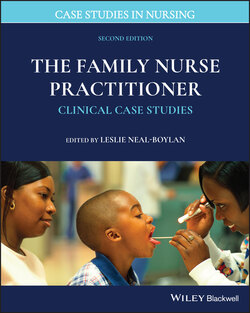Читать книгу The Family Nurse Practitioner - Группа авторов - Страница 23
ОглавлениеCase 2.5 Cough
By Mikki Meadows‐Oliver, PhD, RN, FAAN
SUBJECTIVE
Katelynn, a 7‐month‐old infant, presents to the office with complaints of cough for 2 days and “breathing heavy” since this morning. Katelynn is accompanied by both parents. She has had a fever for 2 days. Her maximum temperature at home was 101°F (rectal). She also has a runny nose. Her mother has tried an over‐the‐counter cough medicine without much relief. Katelynn’s mother has not found much that helps the symptoms; but she notices that, when Katelynn cries, the breathing sounds get worse. Katelynn attends day care and her mother states that many of the kids there have coughs and runny noses. Katelynn’s mother also has had cold symptoms for nearly 5 days.
Birth history: Katelynn was the product of a 40‐week gestation. She was delivered vaginally without complications. During the pregnancy, Katelynn’s mother had no falls, infections, or known exposures to environmental hazards. She did not drink alcohol, take over‐the‐counter or prescription medication (other than prenatal vitamins), use tobacco products, or use illicit drugs. Katelynn’s birth weight was 3300 g and her Apgar scores were 9 at 1 minute and 9 at 5 minutes.
Social history: Katelynn was born to a 31‐year‐old mother. Katelynn has a 2‐year‐old sibling. She lives at home with both parents and her older sibling. Both parents have high school diplomas. The mother works as an administrative assistant, and the father works as a maintenance worker. There are no pets or smokers in the home.
Diet: Decreased solid and liquid intake since yesterday.
Elimination: Decreased urine output; no diarrhea or constipation.
Sleep: Sleep is interrupted by coughing.
Family medical history: Paternal grandfather (PGF) (age 60): history of prostate cancer; paternal grandmother (PGM) (age 59): healthy; maternal grandfather (MGF) (age 61): Type 2 diabetes mellitus, high cholesterol, high blood pressure; maternal grandmother (MGM) (age 61): asthma; mother (age 31): asthma; father (age 30): healthy; sibling (age 2): healthy; history of bronchiolitis.
Medications: Currently taking no prescription or herbal medications. Taking a children’s over‐the‐counter cough suppressant.
Immunizations: Up to date.
Allergies: No known allergies to food, medications, or environment.
OBJECTIVE
Vital signs: Weight: 7.1 kg; length: 65 cm; temperature: 37.9°C (rectal); pulse oximeter reading: 95% on room air.
General: Alert, active, well‐hydrated, interactive baby.
Skin: Clear with no lesions noted; no cyanosis of skin, lips, or nails; no diaphoresis noted; good skin turgor.
Head: Normocephalic; anterior fontanel is open and flat (1.5 cm × 1.5 cm).
Eyes: Red reflexes present bilaterally; pupils equal, round, and reactive to light; no discharge noted.
Ears: Pinnae normal; tympanic membranes gray bilaterally with positive light reflex.
Nose: Both nostrils patent; no discharge; mild nasal flaring.
Oropharynx: Mucous membranes moist; no teeth present; no lesions.
Neck: Supple; no nodes.
Respiratory: RR = 32; barking cough noted; inspiratory stridor with activity; no intercostal, supra‐sternal, or subcostal retractions; no grunting; no deformities of the thoracic cage noted.
Cardiac/Peripheral vascular: HR = 120; regular rhythm; no murmur noted; brachial and femoral pulses present and 2+ bilaterally.
Abdomen/Gastrointestinal: Soft, nontender, nondistended, no evidence of hepatosplenomegaly.
Genitourinary: Normal female genitalia.
Back: Spine straight.
Extremities: Full range of motion of all extremities; warm and well perfused; capillary refill < 2 seconds.
Neurologic: Good tone in all extremities.
CRITICAL THINKING
1 Which diagnostic or imaging studies should be considered to assist with or confirm the diagnosis?___Chest X‐ray (CXR)___Arterial blood gas (ABG)___Complete blood count (CBC)
2 What is the most likely differential diagnosis and why?___Croup (laryngotracheobronchitis)___Bronchiolitis___Epiglottitis
3 What is the plan of treatment, referral, and follow‐up care?
4 Are there any demographic characteristics that would affect this case?
5 What if the patient lived in a rural, isolated setting?
